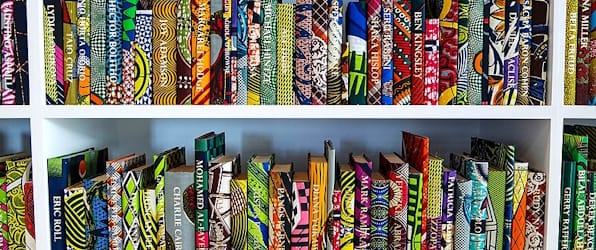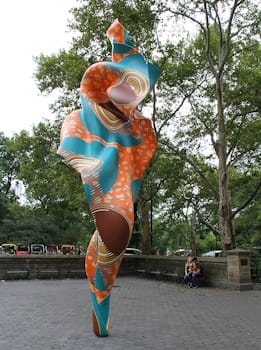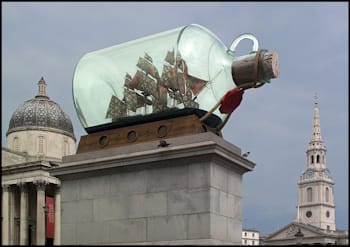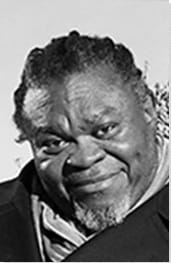Summary of Yinka Shonibare
Artist Yinka Shonibare examines contemporary identity through the loaded and complex lens of post-colonialism. Inspired by his own experiences as a Black man who grew up in both England and Nigeria, his work combines influences from the canons of both Western and indigenous African art, history, and literature to inform conceptual portraits of the unique human experience that emerges from the convoluted relationships spawned by globalization.
Accomplishments
- Authenticity, as it relates to personal identity, is presented by Shonibare as a hybrid construction, representing a marriage of the influences of both one's native environment and the ever-shifting climates that exist when said environment lies prone to the economic, political, and power structures of a ruling presence. This results in art that transcends geographical and cultural borders, challenging traditional notions of identity.
- Shonibare's work questions the overlying narratives, cemented in history and traditionally accepted by a Western majority as truth, by co-opting and examining the icons, motifs, stories, traditions, and memes of the majority consciousness that makes up said history through the filters of the enslaved, culturally dominated, and/or colonized.
- As a Black, disabled artist, Shonibare's creative process is rooted by the motivation to continuously challenge assumptions and stereotypes. This intention extends beyond his artmaking to include work with the disabled, and his involvement with nonprofits that facilitate international cultural exchange, artist support, and ongoing education.
The Life of Yinka Shonibare

Shonibare, who has called himself "a postcolonial hybrid" and a "post-Enlightenment person," says "all of the things that are supposed to be wrong with me have actually become a huge asset. I'm talking about race and disability. They're meant to be negatives within our society. But they're precisely the things that have liberated me. Because they are me, what I express. So, it has not been a negative thing to be who I am but a positive thing."
Important Art by Yinka Shonibare
How Does a Girl Like You Get to Be a Girl Like You?
In How Does a Girl Like You Get to Be a Girl Like You? Shonibare fashioned batik fabrics into Western-style Victorian-era dresses, to adorn headless mannequins, one of whom turns toward the interior of the grouping, while the other two face outward. The artist has explained that the headless-ness was intended as a joke connected to the revenge killings of aristocrats in the French Revolution, saying "the idea of bringing back the guillotine was very funny to me." Culture writer Deborah Sontag notes that "additionally, because Mr. Shonibare does not like his figures to be racially identifiable, chopping off their heads helps."
Curator Elvira Dyangani Ose writes that this work "disassembles at least two metanarratives, namely British-ness - by using a Victorian style symbolic of the British Empire and certain ideas of Britishness - and African-ness, by echoing the contradictory origins of machine-printed batik to illustrate an invented so-called 'African' identity."
This work was the first work of many in which Shonibare used batik fabric he found in the Brixton market. Batik, a method of producing colored designs on textiles by dyeing them, having first applied wax to the parts to be left undyed, is commonly associated with "African" wear yet is actually not at all African. It was derived in Indonesia and manufactured by the Dutch during the colonial era, then exported to their colonies in Africa. As Ose notes, the origins of the fabric "are embedded in an oxymoronic narrative of colonial embezzlements and reappropriations." The artist explains that these fabrics "prove to have a crossbred cultural background quite of their own. And it's the fallacy of that signification that I like. It's the way I view culture - it's an artificial construct." He also notes that "in Brixton, African fabric is worn with pride amongst radical or cool youth [...] It becomes an aesthetics of defiance, an aesthetics of reassurance, a way of holding on to one's identity in a culture presumed foreign or different."
The title of the piece comes from a line spoken by the lead female character in Alfred Hitchcock's 1959 spy thriller North by Northwest. Ose explains that for many contemporary theorists, the archetypal femme fatale in the film noir genre is "powerful, if also usually undone in the end by her desire for power," while for others, she is "suffering a lack of agency in fulfilling a self-formulated representation - a type of internalized repression of her potential to exist sexually outside of the binary of beautiful, duplicitous temptress versus faithful lover." In fact, the figures' decapitation could very easily be seen as a reference to this lack of self-agency.
Dutch wax print cotton on mannequins - Museum of Modern Art, New York
Diary of a Victorian Dandy: 11:00 Hours
Shonibare's 1998 photographic series Diary of a Victorian Dandy was inspired by eighteenth-century English painter and caricaturist William Hogarth's engraved series A Rake's Progress (1735), which depicted the downfall of a young man of "weak moral principles" named Tom Rakewell. Throughout the series, Rakewell becomes increasingly involved in the dark side of eighteenth-century London, indulging in vices such as gambling, drinking, and cavorting with prostitutes, until he is reduced to madness and confined to a mental institution. In Diary of a Victorian Dandy, Shonibare also explores the themes of frivolity and leisure, but presents himself, a black male, as the protagonist: a dandy, whom he calls an "outsider [who] upsets the social order of things." He says, "When you look at somebody like Hogarth, if you see any black people in the paintings, they'd be valets. That's what I was doing there - shifting the central character." By presenting himself as the dandy, Shonibare disrupts traditional racial hierarchies and historical exclusions, compelling a reevaluation of who is portrayed as protagonist in the realms of luxury and moral narratives reserved for the white elite.
The five photographs in the series are labeled by hour, over the course of a day in the life of this dandy. In this image,11:00 Hours, the dandy is still in bed, doted upon by his white servants and maids. In the first image, 3:00 Hours, he engages in an orgy, and in the final image 19:00 Hours, enjoys a feast. These performative photographs were shot on location over a period of three days, in an opulent home in Hertfordshire, with the involvement of professional actors, make-up artists, costumiers, a commercial photographer, and the director of BBC costume dramas. This was the artist's first public commission (for the Institute of International Visual Arts), and the images were originally installed as large posters in advertising spaces in London's underground, but surreptitiously, without any clear indication that they were intended as an art installation. Many viewers thought the images were promoting a theater production. The artist later placed the photographs in faux-gilded frames.
Shonibare once again cast himself as the titular dandy in his 2001 photographic series Dorian Gray based on the 1890 novel by Irish writer Oscar Wilde. The recurrent theme of casting himself as the dandy underscores the artist's critical engagement with identity and the performative aspects of social roles. By placing himself in this archetype, Shonibare not only explores the fluidity of persona but also critiques the power dynamics and cultural constructs that define who can occupy spaces of privilege and visibility. This approach serves as a powerful artistic strategy to question established narratives and to advocate for a more inclusive representation in art and society.
Chromogenic photographs - Collections of Peter Norton and Eileen Harris Norton, Santa Monica, California
The Swing (after Fragonard)
For this installation, Shonibare produced a three-dimensional recreation of the swing from Jean-Honoré Fragonard's 1767 rococo painting The Swing, and upon it placed a headless female mannequin, wearing a batik fabric dress. The swing hangs from a leafy branch, and beneath the figure, a vine with flowers and leaves cascades to the floor. As in Fragonard's painting, Shonibare's figure is frozen at the highest point of her forward swinging motion, right leg bent beneath her, and left leg stretched straight outward. She has just kicked off her left shoe, which floats suspended in the air. Unlike the painting, however, Shonibare has omitted the two male figures watching from the shadows. Instead, the installation's viewer takes on the role of voyeur, peeping at the woman's billowing skirt.
Regarding the materiality of the artwork, curator Okwui Enwezor explains that the batik fabrics are "both fake and authentic, both readymade and original," and that Shonibare uses them "as a tool to investigate the place of ethnicity and the stereotype in modernist representation. [...] The textile is neither Dutch nor African, therefore, the itinerary of ideas it circulates are never quite stable in their authority or meaning." Curator Rachel Taylor asserts that Shonibare represents "a different kind of decorative opulence from Fragonard's silk and lace," and that the work "suggests that the idea of a pure or authentic identity based on traditional notions of nationality, race or class is as anachronistic as a corset and bustle."
The artist himself has explained that "while the leisure pursuit might look frivolous [...] my depiction of it is a way of engaging in that power. It is actually an expression of something much more profoundly serious insofar as the accumulation of wealth and power that is personified in leisure was no doubt a product of exploiting people." Taylor explains that Shonibare's headless coquette "may allude to the literal fate that awaited the aristocracy after the French Revolution; only twenty-five years after Fragonard painted The Swing, the guillotine was introduced in Paris to more efficiently execute royalist sympathizers." Art historian Allison Young writes, that "Drawing our attention to questions of excess, class and morality that were raised by revolutionaries two centuries ago, Shonibare invites us to also consider the increasing disparity between economic classes today..."
Mannequin, cotton costume, two slippers, swing seat, two ropes, oak twig and artificial foliage - The Tate, London, England
Cheeky Little Astronomer
Cheeky Little Astronomer was commissioned for an exhibition at the Astronomer Royal's apartments in Flamsteed House, part of the Royal Observatory Greenwich. The work is composed of a child-sized figure, wearing batik fabric pants and shirt, with a globe head. He kneels, facing backwards on a chair, arms propped on its back, and holding a small telescope to his "face." It was originally placed in front of a window, to emulate gazing up at the outside sky. The artist says that the work "evokes magic. Looking into the stars, there's something aspirational, forward-looking and magical about the piece."
This is one of many works by Shonibare from his Planets in My Head series, in which he uses globes as heads, like Globe Head Ballerina (2012), Refugee Astronaut (2015), Post-Colonial Globe Man (2018), and Young Chemist (2019). He says that "[the globe] represents the world as opposed to this Eurocentric approach," and that it "voids the issue of identity. It prevents the work from alienating groups of people." Moreover, his selection of Victorian-era style globes further emphasizes the connection between his work and the worldwide history of colonialism. He explains that, while Western artists "from Picasso to the present" have been "free to be influenced" by other cultures, there is still an expectation that African artists should "remain indigenous," and thus, he says "If I want to put Victoriana in my work, it's a statement of freedom." In doing so, Shonibare asserts this artistic freedom to engage with and reinterpret the vintage style to explore and express a post-colonial identity that interacts with global history.
Fiberglass life-sized mannequin, Dutch wax-printed cotton textile, leather, resin, chair, globe, and telescope - Royal Academy of Arts, London, England
The British Library
For this discursive, participatory installation, Shonibare curated a collection of 6,328 books, each bound in vibrant batik fabric. On the spines of 2,700 of the books, he elegantly embossed in gold leaf the names of immigrants and their descendants who have contributed to "British life and culture," such as Hans Holbein, Winston Churchill, Zadie Smith, Dame Helen Mirren, Anish Kapoor, and Danny Welbeck. He also included figures like Nigel Farage and Oswald Mosley, known for their opposition to immigration. The remaining 628 nameless books symbolize the ongoing narrative of immigration in the UK, suggesting that this history continues to be written. In front of the shelves sat a desk with chairs and tablets, where viewers could access further information about the people named on the books, as well as share their own reflections on the installation via a dedicated website.
Describes Shonibare, the work "is an exploration of the diversity of British identity through a conceptually poetic lens." Curator Aïcha Mehrez notes that "The work is intended to provoke discussion, debate and reflection on all aspects of British culture, and considers notions of territory and place, cultural identity, displacement and refuge. The sheer number of names, each with their own unique personal and family history, underlines the multiplicity of reasons behind immigration, stressing the impact of global conflicts and economic factors on an individual level. The library format of the work also addresses how knowledge is generated, stored and disseminated, questions with particular relevance in a digital age."
In 2018, Shonibare created two similar installations, The American Library, with names of culturally significant immigrants to the United States, and The African Library, with names of individuals who "played a significant role in the African independence movements." These libraries collectively invite the audience to reconsider the role of immigrants in shaping national identity and cultural heritage in an increasingly interconnected world.
6328 books, Dutch wax-print fabric, gold foil, software, networked world wide web, table, and chairs - The Tate, London, England
Creatures of the Mappa Mundi - Griffin
In 2019, Shonibare produced a series of hand sewn textiles inspired by the Mappa Mundi (which currently hangs in the Chained Library at the Hereford Cathedral in England), the largest medieval world map that survives to present day. Arts writer Elly Parsons explains, that in his vibrantly colored series, Shonibare offers "satyrs, giants and one-legged humanoids, inspired by myths and exaggerated descriptions of boundless travelers [that] have been reimagined, and sewn into the vivid Dutch wax fabrics Shonibare favors." These mythic figures are not only reimagined through the colorful patchwork but are also integrated using techniques like appliqué and embroidery, emphasizing their narrative and visual impact.
The artist's statement highlights the themes of migration and xenophobia in this work, stating that "In the current atmosphere, it is apt to celebrate these unknown outsiders." Through linking the fantastical beings of ancient maps to today's refugees and immigrants, who are often perceived as "outsiders," Shonibare's work reflects "our contemporary concerns of fear of the stranger." He asserts that "recently, obviously because of all the issues around refugees, I've touched on immigration. It's just inescapable. You hear stories of people unfortunately drowning at sea and you're human, you're bound to be touched by that as an artist. Sometimes it's just the absurdity of things or the ignorance around xenophobia. I'm not necessarily literal about the way I want to explore those issues. Sometimes it's going back to history or literature, methodology and using other kinds of folklore and narrative to explore contemporary concerns."
Moreover, Shonibare extends the Creatures of the Mappa Mundi series to address today's environmental concerns through its inclusive and fact-finding creative process . He believes that the "depictions of extinct creatures of legend are a reminder that we may yet become extinct if we do not take care of our environment." Embracing his characteristic participatory approach to art-making, Shonibare engaged diverse local communities in Herefordshire through sewing workshops. These sessions became platforms for discussions on "current hot topics" pertaining to immigration and the environmental issues. Anne de Charmant, the curator, praises this approach as "generous," noting how his collaborations with varied groups, including refugees, the disabled, and the elderly, brought to the project "a rare urgency and vibrancy." She reflects on Shonibare's dedication to generosity as a fundamental artistic value, which she believes greatly enriched the project, making it a poignant yet powerful exploration of pressing contemporary issues.
Patchwork, appliqué, embroidery and Dutch wax-printed cotton textile - Stephen Friedman Gallery, London, England
Biography of Yinka Shonibare
Childhood
Yinka Shonibare was born in London, England to wealthy Nigerian parents Olatunji, a lawyer, and Laide. When he was three years old, the family moved to the Nigerian capital of Lagos, spending their summers in the UK. His childhood involved exposure to a variety of cultural influences from Sesame Street to Nigerian TV programs. At home, the family spoke both Yoruba and English. Shonibare grew up very comfortably and was driven to school by a chauffeur. At the age of seventeen, he returned to England for his A-level examinations at the Redrice School in Hampshire.
Education and Early Training

Shonibare entered the Wimbledon College of Art at the age of eighteen. Just a few weeks after beginning classes, however, he began to feel faint, and collapsed one day. Two weeks later, he woke up in a hospital bed unable to move. It was determined that he had contracted transverse myelitis, an incurable and debilitating inflammation of the spinal cord. The disease resulted in paralysis on one side of his body, and he had to use a wheelchair. He spent a year in the hospital and then a rehabilitation center. Although he regained a significant amount of function, he still sometimes uses a wheelchair and has learned to live with the lifelong effects of his disability. He has referred to this year as "my bottom, bottom period" but adds, "I found out that with a bit of help I was O.K. I could do most things."
Culture writer Deborah Sontag notes "That Mr. Shonibare became a conceptual artist who delegates much of the production of his labor-intensive projects to a network of other artists is partly a result of his disabling illness."
In 1984, Shonibare entered the Byam Shaw School of Art (now part of Central Saint Martins College of Art and Design), graduating with his BA in 1989. In 1991, he earned his MFA from Goldsmith' College (now Goldsmiths University of London). During his studies, Shonibare encountered work by Conceptual and Installation artists like Barbara Kruger, Nancy Spero, and Jenny Holzer, and was fascinated by their use of unconventional materials. He says, "I realized then that I didn't have to be painting on canvas to be an artist. Painting is so historically loaded, anyway - it's like a sign of white male dominance."
Arts writer Kathleen Kuiper explains that "Shonibare's art was placed on its trajectory by the comments of one of his teachers" when he was making work about Perestroika (the period of political and economic restructuring in the Soviet Union during the mid-1980s). Sontag writes that "One day his tutor confronted him. 'Why are you making work about Perestroika?' the tutor, a white Briton, asked. 'You are African, aren't you? Why don't you make authentic African art?' At first Mr. Shonibare was taken aback. 'I tried to figure out what he meant by authentic African art,' he said. 'I didn't know how to be authentic. What would I do if I was being authentic?'"
Says Kuiper, "As someone who had spoken Yoruba at home yet watched British and U.S. television, was perfectly fluent in English, and had lived in both England and urban Nigeria, the artist pondered the meaning of authenticity and the greater significance of his multicultural identity." Shonibare has since stated, "I should have actually understood all along that there is a way in which one is perceived, and there's no getting away from it. And I realized that if I didn't deal with it, I would just be described forever as a black artist who doesn't make work about being black. [...] I realized what I'd really have to deal with was the construction of stereotypes, and that's what my work would be about."

Inspired by the interaction with his tutor to seek out his own language for communicating his multicultural identity, one day in 1989 Shonibare went to an African fabric shop in the Brixton market in South London. He was fascinated to learn that the batik patterned fabrics generally seen as "African" were in fact transcultural in origin, deriving from Indonesian and Javanese fabric designs, manufactured in the Netherlands during the colonial era. The batik method consists of producing colored designs on textiles by dyeing them, having first applied wax to the parts to be left undyed. From then on, he incorporated these fabrics in nearly all of his works as a metaphor for his own identity, and the fact that one's identity is more complex than it appears at first glance, especially when postcolonial histories come into play. As he put it, "I wanted to show I live in a world which is vast and take in other influences, in the way that any white artist has been able to do for centuries."
After completing his MFA, Shonibare worked as an arts development officer for Shape Arts, an organization that makes art accessible to people with disabilities. His big break as an artist came when collector Charles Saatchi bought two of his works in the mid-1990s. Yet, Kuiper notes that "Although Shonibare's work was included in the 1997 traveling exhibition 'Sensation: Young British Artists from the Saatchi Collection' and he was a contemporary of members of the so-called YBAs (Young British Artists) [some of whom, like Damien Hirst, were his peers at Goldsmiths], he considered his concerns to be quite different from theirs." Says Sontag, "Mr. Shonibare was not himself a shock artist. He was not, like Mr. Hirst, suspending sharks in formaldehyde. Rather, at a time when decorative was a dirty word, he was making works of seductive beauty whose bite was only gradually felt." Nor did he feel any connection with the Afro-Caribbean BLK art group active in England at the time, who made fiercely anti-racism protest art. Unlike them, he says, "I had nothing to be angry about."
Mature Period
Since then, Shonibare's work has been exhibited at, and acquired by, major institutions around the world, as well as at Documenta XI in 2002, the thirtieth Sharjah Biennial in 2023, and several editions of the Venice Biennale. In 2003 he became an Honorary Fellow of Goldsmiths' College. The following year, he was awarded an MBE (Member of the Order of the British Empire) given to people for "achievement or service in and to the community which is outstanding in its field and has delivered sustained and real impact which stands out as an example to others."

In 2006, Shonibare began Guest Projects, a non-profit artist residency program in London that seeks to support the "development of early career and African diaspora artists," and which operated out of a former carpet factory in east London before the COVID epidemic in 2020 pushed the project to operate primarily in the digital realm.
In 2010, Shonibare received an Honorary Doctorate in Fine Arts from the Royal College of Art. In 2019, he was honored once again by the British government when he was awarded a CBE (Commander of the British Empire), which recognizes "a prominent national role of a lesser degree, a conspicuous leading role in regional affairs through achievement or service to the community, or a highly distinguished, innovative contribution in his or her area of activity." In 2021, he received the prestigious Whitechapel Art Icon award.
Pleased with the success of Guest Projects, Shonibare launched a similar program, Guest Artist Space (GAS) in Nigeria in 2019, both in Lagos and Ijebu. In 2019, he established the Yinka Shonibare Foundation (YSF), a UK registered charity "dedicated to facilitating international cultural exchange and supporting creative practices through residencies, collaborations and education projects."
Shonibare continues to live and work in London's East End. Though he lives alone in a late-nineteenth-century house, his son Kayode, a computer game designer, lives across the street.
The Legacy of Yinka Shonibare
Yinka Shonibare's work has come to be synonymous with the exploration of postcolonial identity (as well as related themes of globalization, power relations, and authenticity) in art. Culture writer Deborah Sontag calls Shonibare a "senior figure in the British art world but one who intentionally eludes easy categorization [and a] disabled black artist who continuously challenges assumptions and stereotypes." She adds that "when he deals with pithy matters like race, class, disability, colonialism and war, he does so deftly and often indirectly."
Some scholars and critics have reacted negatively to Shonibare and his work, calling his focus on cultural identity "labored, repetitive and a little last decade," or, as one London Evening Standard critic stated, "intellectually feeble-minded." Yet many continue to value his contribution to the international art scene, with Arnold L. Lehman, former director of the Brooklyn Museum, calling Shonibare a "visionary" artist who is "able to juggle so many different ideas so brilliantly and to express them in such an immensely appealing and extraordinarily visual way."
Moreover, as art critic Louisa Buck notes, "Shonibare is also a shining example of philanthropy." In England, Nigeria, and beyond, Shonibare has, for many years, dedicated himself to supporting the careers of emerging artists, particularly those he calls "marginalized or overlooked practitioners who have historically been erased or exploited by the Western art narrative." One participant in such projects, artist Liza Essers (who is also the owner and director of Goodman Gallery in South Africa) has called Shonibare "the most important bridge in my life between the gallery and artists from the continent and the diaspora." Other young artists who have been inspired by Shonibare through their involvement in these projects include Glasgow-based Leo Robinson, Okiki Akinfe (who operates between London and Lagos), Ugandan Katesi Kalange, and Congolese-British Djofray Makumbu.
Influences and Connections

- India Mahdavi
- Doug Fishbone
- El Anatsui
- Liza Essers
- Leo Robinson
- Okiki Akinfe
- Katesi Kalange
- Djofray Makumbu
- India Mahdavi
- Doug Fishbone
- El Anatsui
Useful Resources on Yinka Shonibare
- Yinka Shonibare CBE: End of EmpireOur PickBy Thorsten Sadowsky
- Yinka Shonibare MBE: Revised and Expanded EditionOur PickBy Anthony Downey and Rachel Kent
- Yinka Shonibare MBE: Magic LaddersOur PickBy Judith F, Dolkart
- Yinka Shonibare MBE: Vehicle of MigrationBy Nicholas James
- Yinka Shonibare CBE at the DriehausBy Richard P. Townsend
- Yinka Shonibare: Double DressBy Suzanne Landau
- Yinka ShonibareBy Christine Y. Kim
- Anatomy of Beauty: Black British ArtBy N. P. James
 Ask The Art Story AI
Ask The Art Story AI














